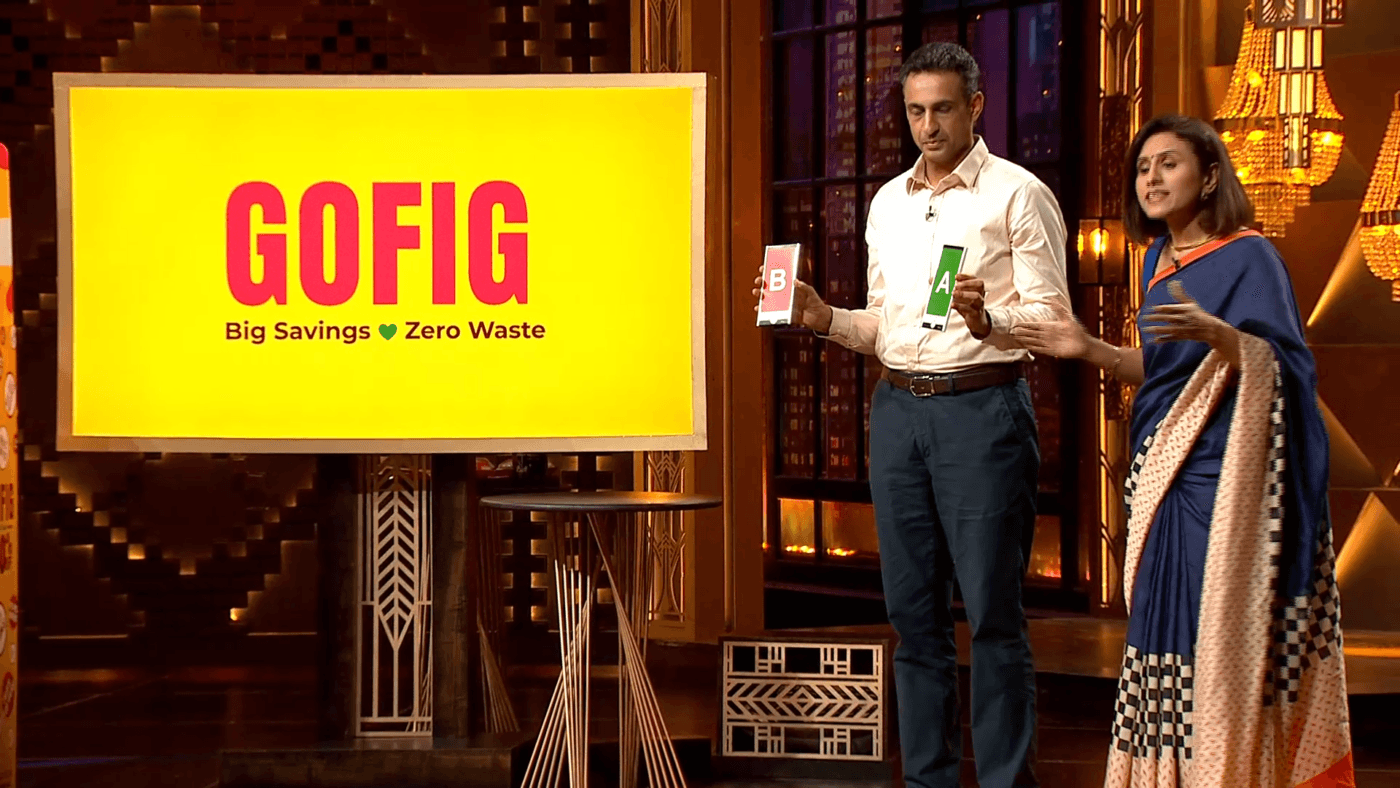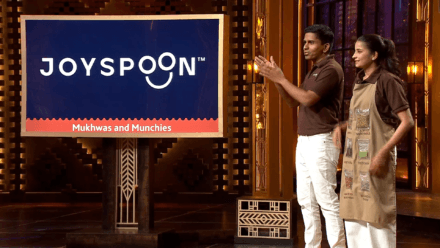GoFig Shark Tank India Episode Review
Website Information
- Website:- GoFig
- Build on E-commerce Shopify
- Poor SEO Performance, SEO improvement is needed.
- ORGANIC TRAFFIC: 63 visitors per month.
Founders
- Disha Shah and Gaurav Shah are the founders of GoFig.
- It was founded with a mission to tackle waste and climate change in India by selling surplus and near-expiry products.
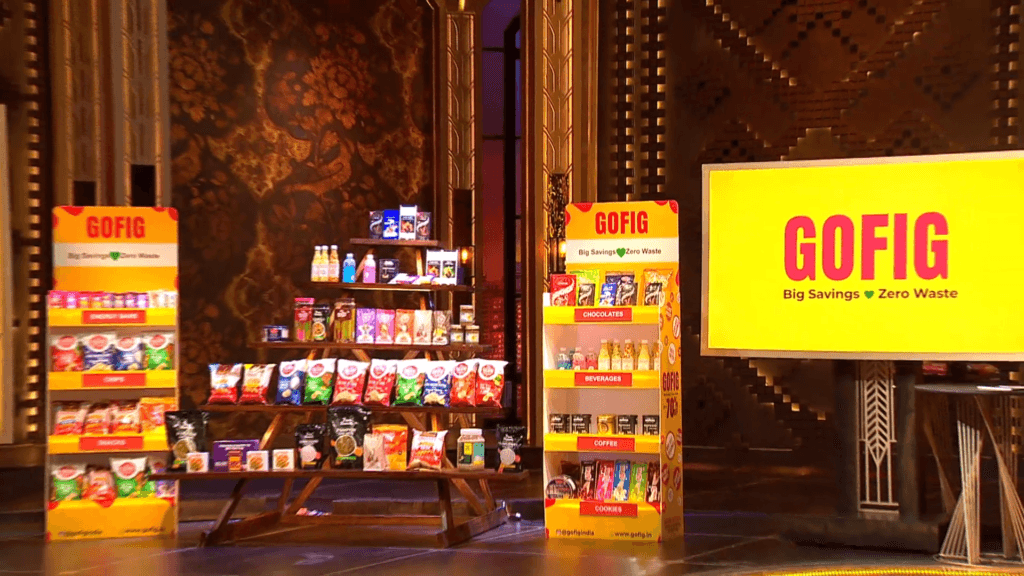
Brand Overview
- GoFig aims to reduce food and FMCG product waste by offering heavy discounts on items nearing their expiry dates.
- It strives to be India’s first green discount company, ensuring these products reach consumers at affordable prices.
- The company partners directly with brands to sell surplus and near-expiry products to consumers.
Shark Tank India Appearance and Ask
- Disha and Gaurav appeared on Shark Tank India Season 4 seeking ₹50 lakh for a 2% equity stake, valuing their company at ₹25 crore.
Season and Episode Air Date
- Season: 04
- Episode: 26
- Episode Air Date: Monday, 10 February 2025
Product Overview
- GoFig sells surplus and near-expiry products, primarily food and FMCG items, at discounted rates.
- These are products that would otherwise be wasted.
Investor Reactions
- The sharks had mixed reactions. Anupam Mittal questioned the founders’ priorities and suggested setting up physical stores instead of a B2B business. Namita Thapar disagreed with Anupam’s views but still backed out.
- Aman Gupta also declined due to the early stage of the business. Ritesh Agarwal agreed with Anupam’s suggestion of physical stores.
- Peyush Bansal offered ₹1 crore for a third of the company, advising them to open a store and change their thought process, but ultimately no deal was made.
- The sharks raised concerns about the business’s execution, scalability, and consumer trust.
Customer Engagement Philosophy
- GoFig aims to make a positive impact on the environment and offer value to consumers by providing affordable prices on near-expiry goods.
Product Highlights
- GoFig focuses on selling products nearing their expiry dates at discounted prices.
- The products include food and FMCG items.
Future Vision
- GoFig intends to continue working on its business model to strengthen it and pursue its mission of reducing waste in the FMCG industry.
Deal Finalized or Not
- GoFig did not secure a deal on Shark Tank India.
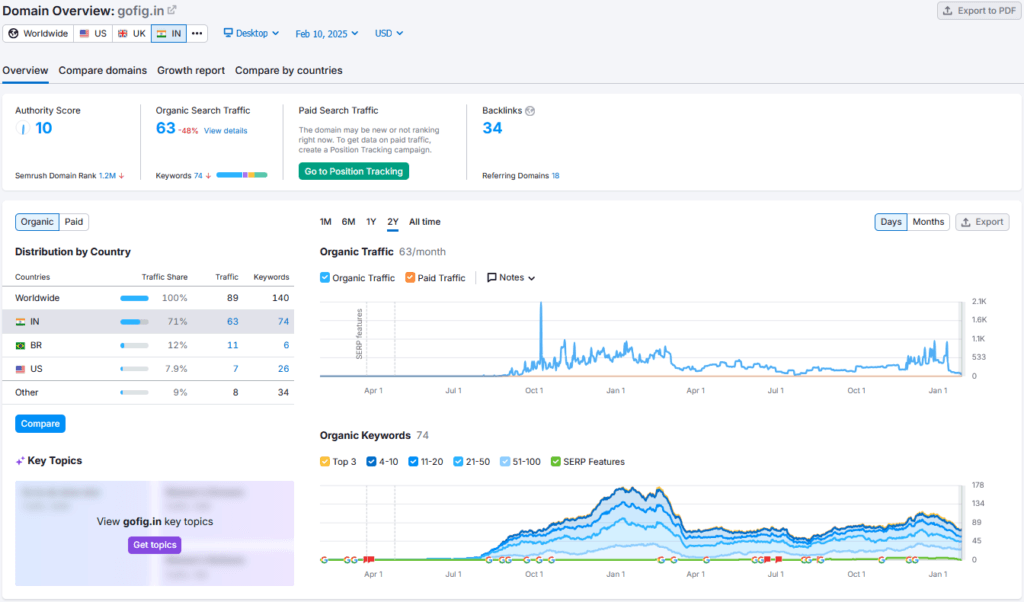
| Category | Details |
|---|---|
| Website Information | |
| Website | GoFig |
| Built on | E-commerce (Shopify) |
| SEO Performance | Poor (SEO improvement needed) |
| Organic Traffic | 63 visitors per month |
| Founders | |
| Founders | Disha Shah and Gaurav Shah |
| Mission | Tackling waste and climate change in India by selling surplus and near-expiry products |
| Brand Overview | |
| Business Model | Selling surplus and near-expiry food & FMCG products at discounts |
| Value Proposition | India’s first green discount company |
| Partnerships | Direct collaboration with brands |
| Shark Tank India Appearance | |
| Season & Episode | Season 4, Episode 26 |
| Air Date | Monday, 10 February 2025 |
| Funding Ask | ₹50 lakh for 2% equity (₹25 crore valuation) |
| Product Overview | |
| Products Sold | Surplus and near-expiry food & FMCG products |
| Purpose | Prevent waste and offer affordable pricing |
| Investor Reactions | |
| Anupam Mittal | Suggested opening physical stores instead of B2B model |
| Namita Thapar | Disagreed with Anupam but still backed out |
| Aman Gupta | Declined due to early-stage business |
| Ritesh Agarwal | Supported Anupam’s idea of physical stores |
| Peyush Bansal | Offered ₹1 crore for 33% equity, advised a pivot, but no deal was made |
| Concerns Raised | Execution challenges, scalability, and consumer trust |
| Deal Finalized or Not? | No Deal |
| Customer Engagement Philosophy | |
| Impact | Reducing waste while providing affordable products |
| Business Potential in India | |
| Waste Reduction | Addresses India’s ₹50,000 crore annual food & FMCG waste problem |
| E-commerce Growth | Leverages India’s expanding e-commerce sector |
| Sustainability Focus | Aligns with rising consumer interest in sustainability |
| Total Addressable Market (TAM) | |
| FMCG Market | Targets discounts on low-shelf-life food & cosmetics |
| Value-Seeking Consumers | Serves price-sensitive shoppers |
| Market Growth Projection | Expected to grow at 7.86% (2022-2029) |
| Target Audience & Demographics | |
| Demographics | Value-conscious consumers, students, and urban families |
| Psychographics | Environmentally conscious, cost-savvy shoppers |
| Digital Natives | Active online shoppers |
| Marketing Strategy | |
| Sustainability Message | Positioning GoFig as a green brand |
| Discount Offers | Highlighting significant savings on near-expiry products |
| Digital Marketing | Social media ads, content marketing, and influencer collaborations |
| Content & Digital Marketing | |
| SEO Improvement | Enhancing SEO for better visibility |
| Content Creation | Educating consumers about food waste |
| Social Media Engagement | Interactive and user-generated content campaigns |
| Distribution Strategy | |
| E-commerce Platform | Shopify-based online store |
| Partnerships with Brands | Direct sourcing of surplus & near-expiry goods |
| Potential Physical Stores | Suggested by investors for better reach |
| Advantages of GoFig | |
| Waste Reduction | Reduces FMCG and food waste |
| Value Proposition | Significant discounts for consumers |
| Sustainability Focus | Aligns with eco-friendly consumer trends |
| Challenges Faced | |
| Consumer Perception | Overcoming skepticism about near-expiry products |
| Logistics & Inventory Management | Ensuring timely distribution of perishable goods |
| Competition | Competing in the e-commerce space |
| Reasons for Potential Success | |
| Unique Value Proposition | Affordable, sustainable shopping model |
| E-commerce Growth | Riding the wave of digital shopping |
| Sustainability Awareness | Increasing preference for sustainable products |
| Mitigation Strategies | |
| Quality Assurance | Strict checks to ensure product safety |
| Transparent Communication | Clearly stating expiry dates for consumer trust |
| Efficient Logistics | Optimizing supply chain efficiency |
| Future Business Plans | |
| Expand Product Categories | Diversifying beyond food and FMCG |
| Geographic Expansion | Scaling to more cities in India |
| Strategic Partnerships | Collaborating with more FMCG brands & retailers |
| Roadmap to Increase Valuation | |
| Increase Sales | Expanding marketing and distribution channels |
| Improve Profitability | Enhancing cost efficiency |
| Build Brand Equity | Strengthening trust through quality and transparency |
| Attract Further Investment | Seeking additional funding for growth |
GoFig Shark Tank India Business Plan
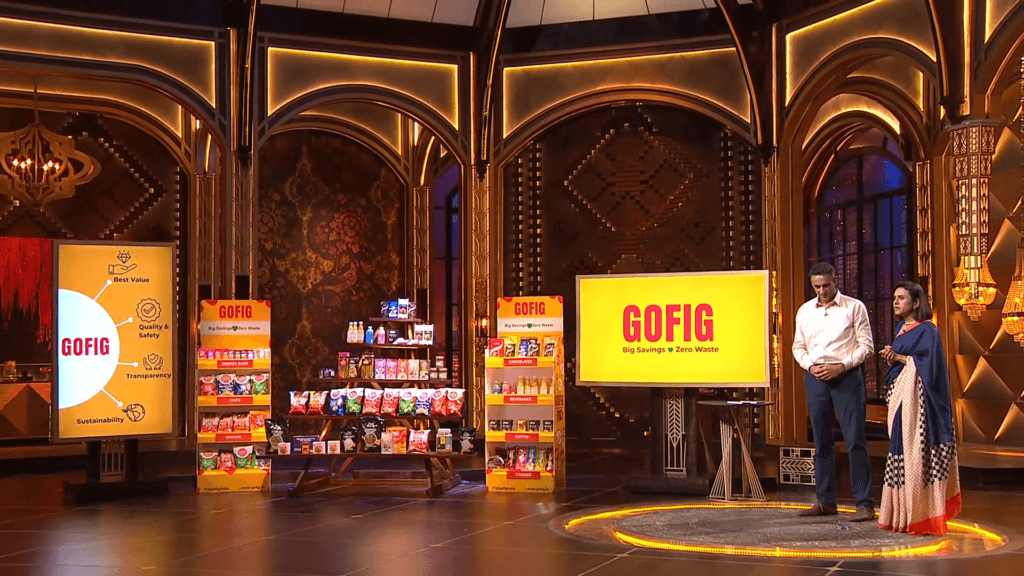
Business Potential in India for GoFig
- Waste Reduction: Addresses the significant problem of food and FMCG waste in India, estimated at ₹50,000 crore annually.
- E-commerce Growth: Capitalizes on the expanding e-commerce market in India, offering a unique value proposition.
- Sustainability Focus: Aligns with increasing consumer awareness and demand for sustainable products and practices.
Total Addressable Market (TAM) for GoFig
- FMCG Market: Targets the large FMCG market in India by focusing on reducing waste through discounts on low-shelf-life foods & cosmetics.
- Value-Seeking Consumers: Caters to the segment of consumers looking for affordable options and bargain deals.
- Business Market Growth: The Business market in India is projected to grow by 7.86% (2022-2029).
GoFig’s Ideal Target Audience and Demographics
- Demographics: Value-conscious consumers, students, and families in urban areas.
- Psychographics: Environmentally conscious individuals seeking affordable products and contributing to waste reduction.
- Digital Natives: Active online shoppers comfortable with e-commerce platforms.
GoFig Marketing Strategy
- Sustainability Message: Position GoFig as a brand committed to reducing waste and promoting sustainability.
- Discount Offers: Highlight the deep discounts and value offered on near-expiry products.
- Digital Marketing: Utilize social media platforms, content marketing, and targeted ads to reach the ideal audience.
GoFig’s Content and Digital Marketing Strategy
- SEO Improvement: Enhance website SEO to increase organic traffic and visibility.
- Content Creation: Develop content that educates consumers on food waste and the benefits of buying near-expiry products.
- Social Media Engagement: Engage the audience with interactive content, user-generated content campaigns, and collaborations with sustainability influencers.
GoFig Distribution Strategy
- E-commerce Platform: Primary distribution channel through the GoFig Shopify-built website.
- Partnerships with Brands: Collaborate directly with FMCG brands to source surplus and near-expiry products.
- Potential for Physical Stores: As suggested by some sharks, consider opening physical stores to cater to bargain-hunting customers.
Advantages of GoFig
- Addresses Food Waste: Provides a solution to the growing problem of food and FMCG waste in India.
- Value Proposition: Offers significant discounts to consumers on quality products.
- Sustainability Focus: Aligns with increasing consumer demand for sustainable products and practices.
Challenges Faced by GoFig
- Consumer Perception: Overcoming potential consumer concerns about the quality and safety of near-expiry products.
- Logistics and Inventory Management: Effectively managing the supply chain and ensuring timely delivery of products before they expire.
- Competition: Standing out in a competitive e-commerce market.
Reasons for the Potential Success of GoFig
- Unique Value Proposition: Offers a unique solution to address food waste and provide value to consumers.
- Growing E-commerce Market: Capitalizes on the expanding e-commerce market in India.
- Increasing Sustainability Awareness: Aligns with increasing consumer demand for sustainable products and practices.
Mitigation Strategies for GoFig
- Quality Assurance: Implement strict quality control measures to ensure the safety and quality of all products.
- Transparent Communication: Clearly communicate the expiry dates and condition of products to build consumer trust.
- Efficient Logistics: Optimize the supply chain to ensure timely delivery of products.
Future Business Plans for GoFig
- Expand Product Categories: Include a wider range of FMCG products and other categories.
- Geographic Expansion: Expand operations to other major cities in India.
- Strategic Partnerships: Collaborate with more FMCG brands and retailers.
Roadmap to Increase Valuation for GoFig
- Increase Sales: Achieve consistent revenue growth by expanding distribution channels, increasing marketing efforts, and building brand awareness.
- Improve Profitability: Focus on cost optimization and operational efficiency to improve profit margins.
- Build Brand Equity: Strengthen brand image and customer loyalty through transparent communication, quality assurance, and sustainability initiatives.
- Attract Further Investment: Secure additional funding to fuel growth and expansion.

